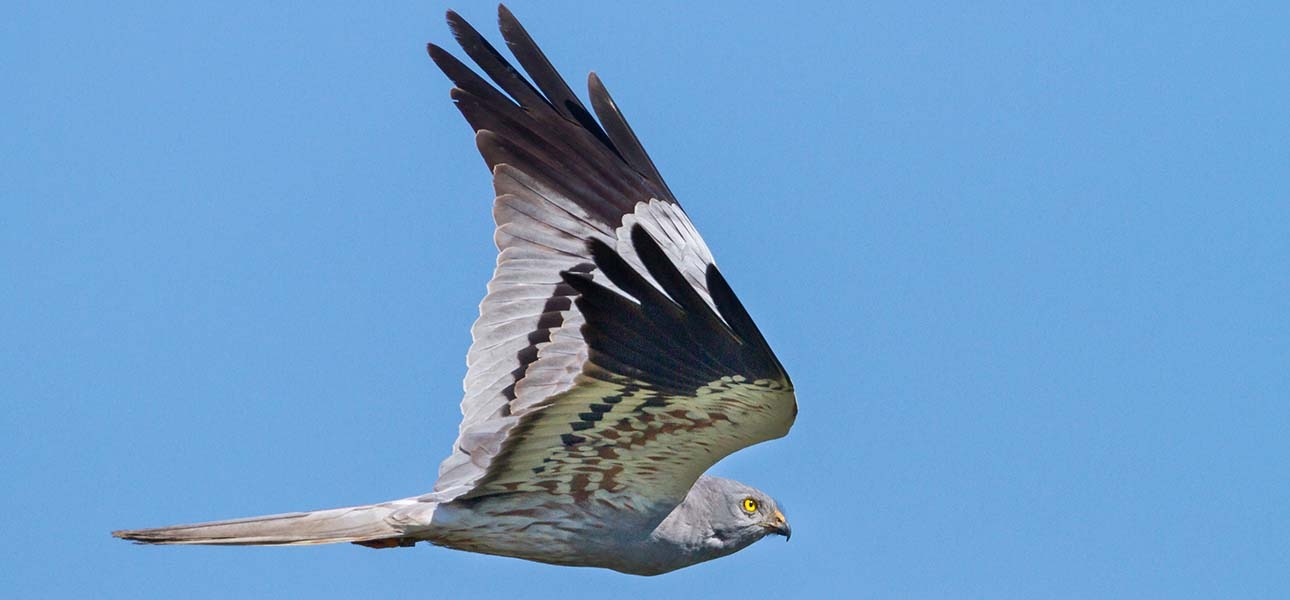Montagu’s Harrier
Circus pygargus
Montagu’s Harrier is by far our rarest breeding harrier and has partially recovered from near extinction in the 1970s. They are long distance migrants and recently most have nested in arable crops, making them vulnerable to early harvesting or crop management. They rely very heavily on nest protection in this habitat.
They are much smaller birds than Hen Harriers, but have similar length wings, making them even more buoyant and agile. Males are more heavily marked than Hen Harriers, with a dark band on the upper wing, and a series of dark and rufous bands on the underwings. Although grey above, they are marked below, giving them a very different impression. Females can initially seem very similar to Hen Harrier, although the long, narrow wings should help. There are only four visible ‘fingers’ at the wing tips and young birds are a rich rufous colour, likely only to be mistaken for young Pallid Harriers – a rare visitor to the UK.
They are named after George Montagu (1753-1815), an English army officer and naturalist best known for his pioneering Ornithological Dictionary and discovering that the bird now known as Montagu’s Harrier bred in the UK.
VITAL STATISTICS
Size: Average 45cm, wingspan 112cm. Females (380g) larger than males (270g).
Status. Migrant breeding bird. Passage visitor.
Population size. 15 breeding pairs.
Conservation status: AMBER (due to recent population and range decline)
Lifespan: Average lifespan is 6 years, with an adult survival rate of 72% year on year. Juvenile survival is not known. They begin breeding at age of 3 and the oldest known wild bird, was almost 8 years old (ringing recovery).
Nesting: Unlike Hen Harrier, although Montagu’s Harriers will nest on heathland or marshland, most nest in the UK in arable fields, where they do stand the risk of failing due to agricultural activities such as crop spraying.
Number of eggs: 4-5
Incubation: 28-29 days
Fledging time: 35-40 days
Habitat and Distribution: Montagu’s Harrier has always been a scarce if widespread breeding bird in the UK, although numbers crashed. By 1075 there was only one nest, but numbers have slowly recovered a little since then. It is now found in two areas, on the east coast around The Wash and north into Lincolnshire and south Yorkshire; and a second core area in central southern England. Birds can be found hunting over a range of open areas with low vegetation but most UK birds nest in farmland crops.
Movements: Unlike their cousins, Montagu’s Harriers are long-distance migrants and spend the winter in Africa south of the Sahara. The species is widely distributed across Europe and Asia, wintering in Africa and India, but is seldom common.
Feeding: Montagu’s Harriers hunt in a similar way to other harriers, slowly working back and forth across an area at low altitude watching and listening for prey, which may consist of small mammals, birds, and other similar-sized animals. Due to the long and large wings, Montagu’s Harriers are more agile than other harriers and are able to tackle more agile prey.

